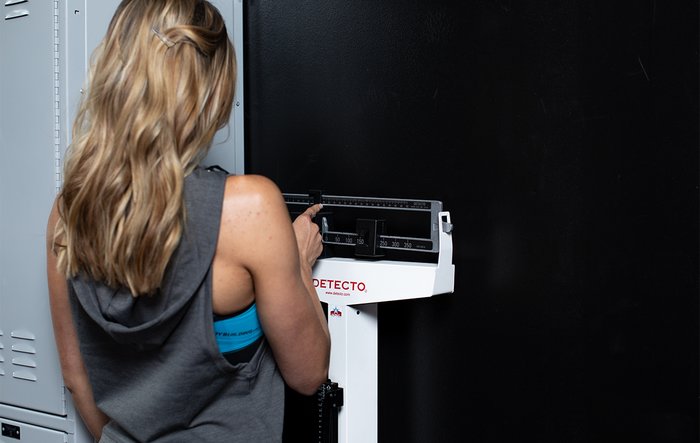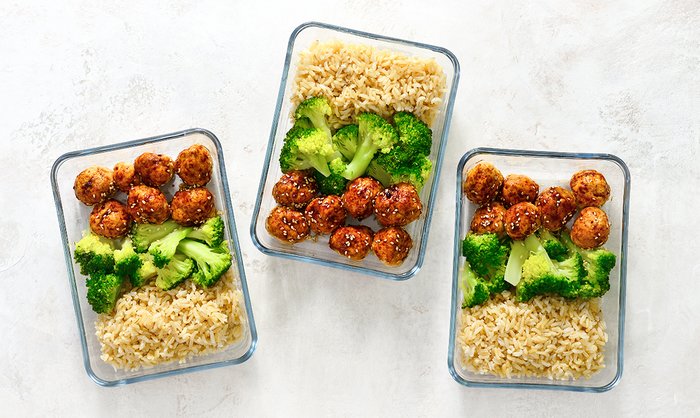Products You May Like
Although calorie counting seems cumbersome and is often ignored, calories in and out remains the number one factor affecting weight loss or gain. When you’re active in the gym and want to build muscle or lose fat, it’s ideal to eat the most that you can while still getting results. So, caloric intake is pretty much a non-negotiable measurement to keep track of.
For those wanting to maintain their weight and stay healthy, knowing how many calories you’re taking in a day will also help you avoid health pitfalls like hormone imbalance, poor training performance, nutritional deficiencies, or undesired changes in body composition.
It’s not just important to know for the sake of appearance. With the national obesity epidemic and the debilitating health issues it brings, it seems foolish to ignore the most effective tool we have for manipulating weight—nutrition. Many people are able to improve blood triglycerides and heart health, reduce their risk of diabetes and cancer, and live a longer, more fulfilling life when they lose unneeded weight.
On the flipside, gaining weight is how we build muscle, but there is an optimal way to do that without stuffing your face at every meal and putting on excess body fat.
Bottom line: It all involves tracking daily calories.
So, how do you make sure that you’re getting what you need to meet your goals? It’s time for some simple, straightforward steps to calculate how many calories you need.
Calorie Needs for Weight Maintenance
No matter your goal, calculating your maintenance calories is the first step and you can do this with simple math equations. Calorie calculators like ours can be a good starting point, but if you want to understand the human body and get as close to accurate numbers as possible, it’s worth putting those elementary math skills to use.

The most up-to-date equation for calculating your caloric intake is the Katch-McArdle equation. The popular Mifflin-St. Jeor equation doesn’t account for lean body mass but is still accurate (within 10 percent) for most people.[1] Both equations have shortfalls and are only an estimate of calorie needs. Katch-McArdle fails to account for total body weight, age, height, or gender, while Mifflin-St. Jeor leaves out lean body mass.
For this discussion, we will use the Katch-McArdle equation, which is well-suited for those who aren’t obese and have a decent amount of muscle. It will give you your basal metabolic rate (BMR), which is the number of calories necessary to sustain your various body systems: nervous, digestive, circulatory, endocrine, reproductive, and so on. The BMR does not include calories needed to support daily activities or exercise.
Here’s the equation in kilograms and pounds:
- BMR = 370 + (21.6 x lean body mass in kilograms)
- BMR = 370 + (9.8 x lean body mass in pounds)
Step 1. Calculate Body-Fat Percentage and Lean Mass
Your lean body mass is your total weight minus the body fat. This will be the chief determinant of your calorie needs. The ideal would be to have your body fat tested, as it is the most accurate method, but if you have a somewhat accurate estimation of body-fat percentage and your current weight, you have everything you need to figure out your lean body mass.
One way to determine your body fat percentage is to measure the narrowest part of your waist, the widest part of your hips, and your neck just below your voice box. Then, plug your measurements into the U.S. Navy Body Fat Calculator. The Navy method is accurate within 4 percent, it but does tend to overestimate body-fat percentage.[2,3]

You can also have your body-fat percentage taken using a caliper. This tool is inexpensive compared to hydrostatic weighing, and you can do it yourself or have a friend or family member help. While a caliper is not ideal, it’s inexpensive and a quick way to get a good estimate.
Once you have your body-fat percentage, it’s easy to find your lean body mass. Let’s say you weigh 150 pounds, and you figure out that you are around 30 percent body fat. That means you are 70 percent fat-free mass.
Using simple math, 70 percent of 150 pounds (0.7 x 150) equals 105 pounds of fat-free mass.
Step 2. Determine Your Basal Metabolic Rate
As discussed, the BMR is the number of calories necessary to sustain your body’s various systems. To find this number, plug in your lean body mass to the Katch-McArdle equation:
- BMR = 370 + (9.8 x lean body mass in pounds)
- BMR = 370 + (9.8 x 105)
- BMR = 370 + (1,029)
- BMR = 1,399 calories
In this example, your basal metabolic rate would be about 1,400 calories.
Step 3. Determine Total Daily Energy Expenditure
Your total daily energy expenditure, or TDEE, is the total energy you burn in a day. This includes calories burned in daily activities like doing the laundry, driving, and even fidgeting, as well as calories burned through exercising. An activity factor will add the necessary calories to accommodate your physical activity, on top of your BMR.

See the examples below to help you nail down the proper activity factor based on your activity level.
Activity Factor:
- BMR x 1.1-1.2
Description:
- Sedentary: most of your time spent sitting (office worker, driver, student, etc.) with little to no exercise.
Activity Factor:
- BMR x 1.3-1.4
Description:
- Lightly active: most of your time spent standing or working with hands (clerk, bartender, police officer, heavy equipment operator, etc.)
- Sedentary with 20-30 minutes of moderate exercise per day (brisk walking, bicycling, rowing, circuit training, vigorous weight training)
Activity Factor:
- BMR x 1.5-1.6
Description:
- Moderately active: most of your time spent walking or moving objects under 25 pounds (janitor, nurse, server, electrician, courier, etc.)
- Lightly active with 20-30 minutes of moderate exercise per day
- Sedentary with 45-60 minutes of moderate exercise per day
Activity Factor:
- BMR x 1.7-1.8
Description:
- Very active: most of your time spent doing physical labor such as moving objects between 25-50 pounds (carpenter, mechanic, landscaper, etc.)
- Moderately active with 20-30 minutes of moderate exercise per day
- Lightly active with 45-60 minutes of moderate exercise per day
- Sedentary with 2-3 hours of moderate exercise per day
Activity Factor:
- BMR x 1.9-2.5
Description:
- Extremely active: most of your time spent doing heavy labor such as moving objects over 50 pounds (roofer, construction worker, farmer, miner, etc.)
- Very active with 45-60 minutes of moderate exercise per day
- Moderately active with 2-3 hours of moderate exercise per day
Continuing our example, let’s say you have a sedentary job and work out 4-6 hours per week. You would use an activity factor of 1.5 since you’re not exercising a full hour each day. Multiply your BMR by your activity factor to get your TDEE. Recall that your BMR is about 1,400 calories.
- TDEE = BMR x activity factor
- TDEE = 1,400 calories x 1.5
- TDEE = 2,100 calories
So you would need to get approximately 2,100 calories a day to maintain a body weight of 150 pounds and 30 percent body fat with lifestyle considerations. And of course, your diet should include a healthy mix of protein, carbs, and fat. You can calculate the exact macronutrients with our macronutrient calculator.
Calorie Needs for Fat Loss
To achieve sustainable weight loss, I suggest a modest calorie deficit of 20-30 percent of your TDEE, and to follow that for no longer than six months at a time to avoid metabolic slowing.
So, if you need 2,100 calories to maintain weight, you would consume between 1,470-1,680 calories to lose fat. If you’re already eating at 70 percent of your TDEE and have hit a weight-loss plateau, it’s better to add more activity into your routine rather than slash your food intake any further.
Calorie Needs for Weight Gain
What about healthy weight gain? My guess is that you’re trying to gain muscle, not fat. At best, a natural bodybuilder doing everything perfectly can put on only 2 pounds of muscle per month, or half a pound per week.[4] Since an increase of 3,500 calories yields approximately 1 pound of weight gain, half a pound of gain would require an additional 1,750 calories per week, or 250 calories a day.
Don’t worry, we are still talking snail’s pace weight gain. The goal is about 0.5-0.75 pounds per week for lean mass gains. To achieve it, start by adding 300 calories to your current daily intake—or start more cautiously at 200 calories if you prefer—and maintain that intake until you stop gaining. At that point, add another 200-300 calories and repeat.

I recommend having body-fat measurements taken every 1-2 weeks during this process to make sure your lean mass is increasing steadily while body-fat percentage barely creeps up. A good rule of thumb is no more than a 5 percent increase in body fat for every 16 weeks of muscle building.
Of course, it’s impossible to ensure that every extra calorie you consume goes to increased muscle mass with zero increase in body fat. If only nutrient partitioning were that perfect! To truly max out your lean-mass gains (that is, put on the most amount of muscle possible over a period of time), you should be willing to accept a small amount of fat gain. This is especially true if you are transitioning out of a very lean state, such as post-competition.
Adjusting Your Calorie Intake
These guidelines should give you a solid starting point, but always listen to your body. Your calorie needs may be slightly higher or lower than your calculations, and you will likely need to adjust your intake based on your body’s response, as well as if your goals change.
For example, if you are trying to shed some fat but are losing less than a pound per week, or if you’re trying to add lean mass but gaining too much fat, cut 100 calories from your daily intake. Measure your results after one week and adjust again, if needed (always in small increments!). Or, if you’re consistently losing more than 2 pounds per week (potentially losing muscle) or failing to measure any increase in muscle mass while attempting a lean bulk, add 100 calories to your daily intake and track your results.
If you are maintaining well below your calculated TDEE (for example, your calculated TDEE was 2,100 calories but you’ve been maintaining at 1,600 calories or less), it indicates that you’ve been dieting or under-eating long enough to significantly slow your metabolism. In this case, the best solution is to reverse diet, which is to add calories gradually until you reach that calculated maintenance level.
Be patient when making changes. Just because you don’t see results after week one doesn’t mean you should start one of those extreme fad diets or eat everything in the fridge. Anything worthwhile takes time, and this is no different!
Want more info about fitness nutrition? Check out Bodybuilding.com’s Foundations of Fitness Nutrition course to learn the essentials of eating right for any goal.
References
- Frankenfield, David, et al. (2005). Comparison of predictive equations for resting metabolic rate in healthy nonobese and obese adults: a systematic review. Journal of the American Dietetic Association, 105(5), 775–789.
- Combest, Travis M., et al. (2017). Comparison of circumference body composition measurements and eight-point bioelectrical impedance analysis to dual energy X-Ray absorptiometry to measure body fat percentage. Military Medicine, 182(7).
- Babcock, Carmen J., et al. (2006). A comparison of military circumference equations to skinfold-based equations to estimate body composition. Military Medicine, 171(1), 60–63.
- McDonald, Lyle. (2017) General philosophies of muscle mass Gain. Bodyrecomposition.
